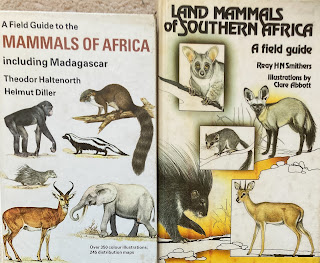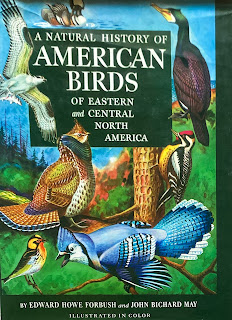As many Birders and Wildlife enthusiasts will confirm, their Wildlife interests can be addictive. A few weeks ago, local Birder Martin Wood posted the following tweet on Bluesky.
The Bluesky Tweet that started everything
This included the text "Nature book challenge. A book per day, in no particular order, until you've shared all of the best nature, environment and conservation books in your personal library. No explanations, no reviews, just covers!". In this Blog Post, I get to explain some of the books I've been tweeting about in response to Martin's tweet.
The AA Book of the British Countryside: My first general Wildlife book, which covered Birds, Insects, Flowers and anything else relating to the countryside
The AA Book of the British Countryside: The pages contained an A to Z of the British countryside
Martin's tweet tapped straight into my Bird book addiction. I've always loved books since I was a small kid. Early in my student days at Southampton University, I visited both the University library and the main city library. However, both left me feeling they didn't have that many good Bird and Wildlife books. But the reality was there were few decent Bird field guides or handbooks in those early days to stock. Additionally, any good guides couldn't be kept out on constant loan for reference purposes.
My early UK field guides and handbooks: There was also The Birds of the Western Palearctic. But that was beyond my student budget and new volumes were appearing too slowly to be useful, especially for tricky Passerines
There was only one answer to this problem: to start my own Bird and Wildlife book collection. By my second year, I had discovered a local secondhand book shop close to my student accommodation. I was a frequent visitor and occasionally, I left with some good books. But the size of the library at that point was constrained by the reality of having to survive on a student grant.
My first New World book: In hindsight, one of the few books I bought where the three quid I paid for it would have been better spent on booze
The mid-80s, saw the first of the Croom Helm monographs, when the Seabirds book was published.
The first edition of the Seabirds book: This volume is a bit battered after taking it on an extended two month trip to Australia and New Zealand. We decided that the existing field guides were inadequate for some of the Seabirds we were hoping to see
Over the next couple of decades there were several new family monographs published each year: virtually all of which were quickly snapped up. Knowing a mate who could source them at about thirty percent discount certainly helped in those days and I was also able to include quite a few other friends in those book orders.
The Seabirds book was the start of a lot of excellent family monographs from Croom Helm, Pica Press, OUP and Poyser
But there were some other significant family monographs available in the late 80s that were worth buying. Occasional visits to some of the top London bookshops helped, as well as, buying books at Oriental Bird Club meetings. The family monographs really helped as they provided a world view of a family or group of families, which helped to fill the gaps caused by some of the poor quality field guides that were the only option in those early days.
Parrots of the World: This is one of my favourite Bird books thanks to the great plates by William T Cooper, who is one of my favourite Bird artists
The Kea plate by William T Cooper: This book was published in the days before the current generation of excellent artists
By the late 80s, I was planning to give up my job in Autumn 1990 and go travelling around the world with my mate, Keith Turner. The logistics of that trip were complex. Firstly, there was the obvious one of deciding on a route. Next was pouring through many tens of Bird reports to condense that information into a couple of master notebooks of sites and species to target. But the other problem was the number of field guides we needed to carry. We made that a bit easier by planning a four month African and Madagascan leg, before returning to the UK.
Three of the four guides we used on the African leg: The book with the dull cover is the bulky, but not too heavy, Mackworth Praed and Grant West African Passerine handbook. This was useful when we visited Rwanda and the South West corner of Zaire: a corner of a country that hasn't been safe to visit for most of the last thirty-five years. The fourth book was Keith's French plates for the Birds of Madagascar. This was another country which didn't have a field guide in 1990. I also took an invaluable distribution guide for Madagascar
We starting again with the India Subcontinent, South East Asia, Hong Kong, Indonesian and Australian leg. Along the way, a trip into China was added. The logistics of weight were helped by the lack of the decent field guides we needed to carry and we could split those field guides between the two of us. To help with weight they were posted home after we had finished using them. Keith & I were able to spend a lot more time in each country before moving to the next country and this allowed us to build up a lot more experience of the Birds to make up for the poor quality of the field guides. We were also carrying photos of some of the plates from the first family monographs, as well as, from other field guides that we too heavy to carry.
Field guides for fifteen months Birding from India and Nepal, Hong Kong, China, to South East Asia, Indonesia and Australia
The country that presented the largest challenge was Indonesia. We visited Indonesia, including Irian Jaya (now West Papua) when few Birders had travelled away from Java and Bali. We covered all the main islands over three extended trips totally sixteen weeks. The only part of Indonesia we skipped was Kalimantan, as we spent about six weeks in Sabah over two trips. Irian Jaya should have been longer for me, but a motorbike accident left me unable to consider a second major trek to Wamena. The biggest challenge at the time was Wallacea, as the only available book was the BOU Checklist for Wallacea, with no descriptions or illustrations. There was no field guide for any of these endemic rich islands in those days.
The excellent BOU Checklist to Wallacea
We had a couple of useful reports for each of the main islands, there were few options in each family on any island and where there were options, the BOU Checklist provided details on locations, elevations etc. This was helped by a few sketches in a couple of the reports we had. I was taking descriptions of every species and when I checked all those descriptions against the excellent Birds of the Indonesian Archipelago, I found only two or three species that we had misidentified.
The excellent Birds of the Indonesian Archipelago: This is one of my favourite field guides
By the start of the millennium, I had itchy feet and I decided I needed to go travelling again on another long trip. Fortunately, I was aware that IBM would allow employees to request up to a year of sabbatical leave. My plan was to travel for a year from Oct 2001 to the Philippines, New Zealand and its Subantarctic Islands, to zig-zag across multiple Pacific islands before reaching the New World: with stops in Mexico, Costa Rica, Peru and Chile. Fortunately, all of these countries had a field guide, but I was also carrying laminated photos of plates from other useful handbooks like The Birds of South America and The Birds of the High Andes. This was an enhancement on the original photos I had carried on previous trips. Whilst heavier and bulkier, they were waterproof, which the original photos weren't.
The Birds of South America: It was good that they started on the Passerine volumes, but a pity they never published the Non Passerine volumes
The Birds of the High Andes: This is another excellent handbook but too heavy and expensive to put in a rucksack
Around this time, the wonderful Handbook of the Birds of the World started being published. When I travelled to Brazil in 2004, we were carrying laminated scanned images of all the relevant plates from those volumes that had been published, as Sick's Brazil guide was so poor. But I wasn't going to wait for a decent field guide as I was wanting to see a Sharpbill: which was the only Bird family I hadn't seen by that point. That at least was easy to identify, albeit we probably threw one of two more tricky species away, due to the lack of a decent field guide. Unfortunately, since that date, about another fifteen Bird families have been split and there are still eight I've yet to connect with: but that's another story.
The excellent Handbook of the Birds of the World series
Moving closer to the current date, Birders have it easy these days as virtually every country now has an excellent field guide for the country or region, not to mention a plethora of tour operators and guides to take them around their chosen country. Albeit trying to follow the same route that we covered in the 1990 - 1992 Round the World trip, would result in bags being vastly heavier than the average of about forty-five kilos we somehow managed to smuggle past the airport check-in staff. I won't photograph any of these modern field guides, as they can easily be found in any of the online sites selling decent Bird books today.
The Birding Frontiers Challenge Series from the late Martin Garner is another excellent series: It was a real loss to the Birding community to lose Martin and a shame that nobody was brought in to continue this series
Another interesting and unique book concept came from the Sound Approach. This series of Bird books focused on European species and their vocalisations. The books came with CDs, so you could listen to the songs of the species they were discussing.
Another ground-breaking series came from Bob Flood and Ashley Fisher, where the books are packed with detailed information, good photos and accompanying DVDs containing videos at sea.
The Seabird series from Bob Flood and Ashley Fisher
I will end this Blog Post with another favourite Bird book: the sixteen inch high Birds of Paradise and Bower Birds, which is another book illustrated by William T Cooper.
The Birds of Paradise and Bower Birds
The Wilson's Bird of Paradise plate: This remains the best Bird I've seen, despite only watching a sub-adult male displaying. Keith & I were some of the first independent Birders to go looking for Wilson's Bird of Paradise and before any of the tour companies started taking punters into the area
There are plenty of other Wildlife books in the library. I will cover some of them in the next Blog Post.





































































